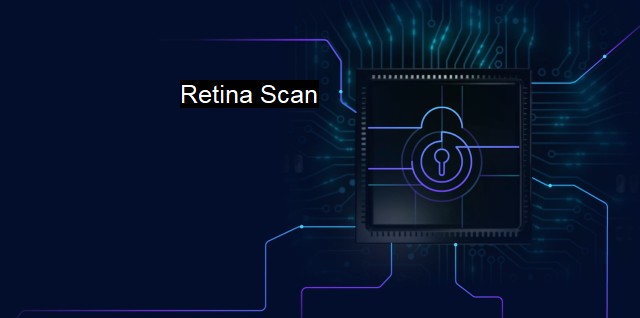What is Retina Scan?
Secure Digital Protection: Retina Scanning Technology - Enhancing Identification and Access for Cybersecurity
Retina scanning is a biometric technique that involves analyzing the unique pattern of the eye’s retina to authenticate and verify the identity of an individual. It capitalizes on the intricate formation of capillaries on the retina, which exhibits about an individual's genetic composition and health. The characteristics of a person’s retina are believed to be so distinctive that no two individuals, even identical twins, have the exact same pattern. This makes retina scanning a valuable tool for enhancing cybersecurity protocols and prevention systems including antivirus properties.Their inclusion in the arsenal of security infrastructure provides protective architecture to cater to logical facilities such as data centers and cybersecurity networks. It acts as an effective measure against potentially malicious external attacks targeting security breaches. It greatly enhances password and username protocols with its biological credentials that are impossible to misplace, difficult to replicate, and inherent to the person only.
The scanning process begins with focusing on a low-intensity light source, like an infrared light, into a person’s eye. As the light is cast upon the eye, it traces a circular path on the retina, thus illuminating a thin line across the retina. The differential refractive index of the blood flowing in the vessels obstruct the light, causing a variation in the intensity of the reflected light seen through the optical system. These variations are then converted into electrical signals to generate a digital representation of the pattern.
The distinctive aspect of an individual's retina should not be mistaken with the data encapsulating the process of retina scanning. The detail captured during scanning involves numerical data that serves as unique identifiers, making it complex for cybercriminals to compromise the intricate and unique retina data. This assists in mitigating potential threats such as identity theft, unauthorized access or malicious attacks on vital systems.
In conjunction with other aspects of cybersecurity systems, retina scanning makes an extremely difficult target for breaching, providing a new layer of security that complements password and security questions. It becomes almost impossible for malicious actors to dupe or spoof a biological system.
Retina scanning is also advantageous to virus protection software. It acts as a potential deterrent to bot attacks or hacking attempts, making it difficult for rogue applications or scripts aimed at unauthorized access to penetrate the system. Given that the technology hinges on unique physical characteristics, it cannot be tampered with by malware that targets software weak points.
There's no worry about attacks from dictionary-based hacking as passwords are not employed, leaving malware with no attack surface for exploiting. Unlike conventional methods, this drastically decreases the risks and impact of infestation by any malicious software or antivirus threats. It further cements the system's resilience to data usurpers or malignant hackers aiming to acquire sensitive information.
Like every technological advancement, there are concerns tied to the usage of retina scanning technology. Privacy implications could be an issue, since access to such deeply personal information may confuse boundaries. The threat of potential biological damage due to the exposure of the eye to the infrared light used in some devices is also a concern. Yet, advancements are continually made to mitigate these issues and ensure the safe and effective implementation of retina scanning as a cybersecurity measure.
As cybersecurity threats become increasingly sophisticated, retina scanning offers a highly secure method of authentication that can enhance security infrastructures. By unique biological identifiers and being nearly impenetrable by malware, retina scanning augments traditional security measures, providing essential defenses in our vitally connected world. As we advance in the cybersecurity space, biometric technology like retina scanning will undoubtedly play a significant role in shaping a safer digital ecosystem.

Retina Scan FAQs
What is a retina scan?
A retina scan is a biometric technology that uses a digital image of a person's retina to identify and authenticate them. It is a non-invasive process that captures unique features of the retina, including blood vessels and nerve patterns, which are then used to create a biometric template.How is a retina scan used in cybersecurity?
Retina scans are commonly used as an additional layer of security authentication in cybersecurity. They can be used to prevent unauthorized access to sensitive data or systems by ensuring that only authorized users with the correct security clearance are granted access.Is a retina scan a reliable form of security?
Retina scans are considered to be one of the most reliable and secure forms of biometric authentication for cybersecurity. This is because the retina is a unique and stable feature that cannot be easily replicated or altered. However, like any security technology, it is not foolproof and can still be susceptible to hacking or fraud in certain circumstances.Are there any privacy concerns with retina scans?
Retina scans are generally considered to be safe and non-invasive. However, there are some privacy concerns associated with the use of biometric data, including the potential for misuse or unauthorized access. It is essential to ensure that proper security protocols are in place to protect the privacy and security of individuals' biometric information.| | A | | | B | | | C | | | D | | | E | | | F | | | G | | | H | | | I | | | J | | | K | | | L | | | M | |
| | N | | | O | | | P | | | Q | | | R | | | S | | | T | | | U | | | V | | | W | | | X | | | Y | | | Z | |
| | 1 | | | 2 | | | 3 | | | 4 | | | 7 | | | 8 | | |||||||